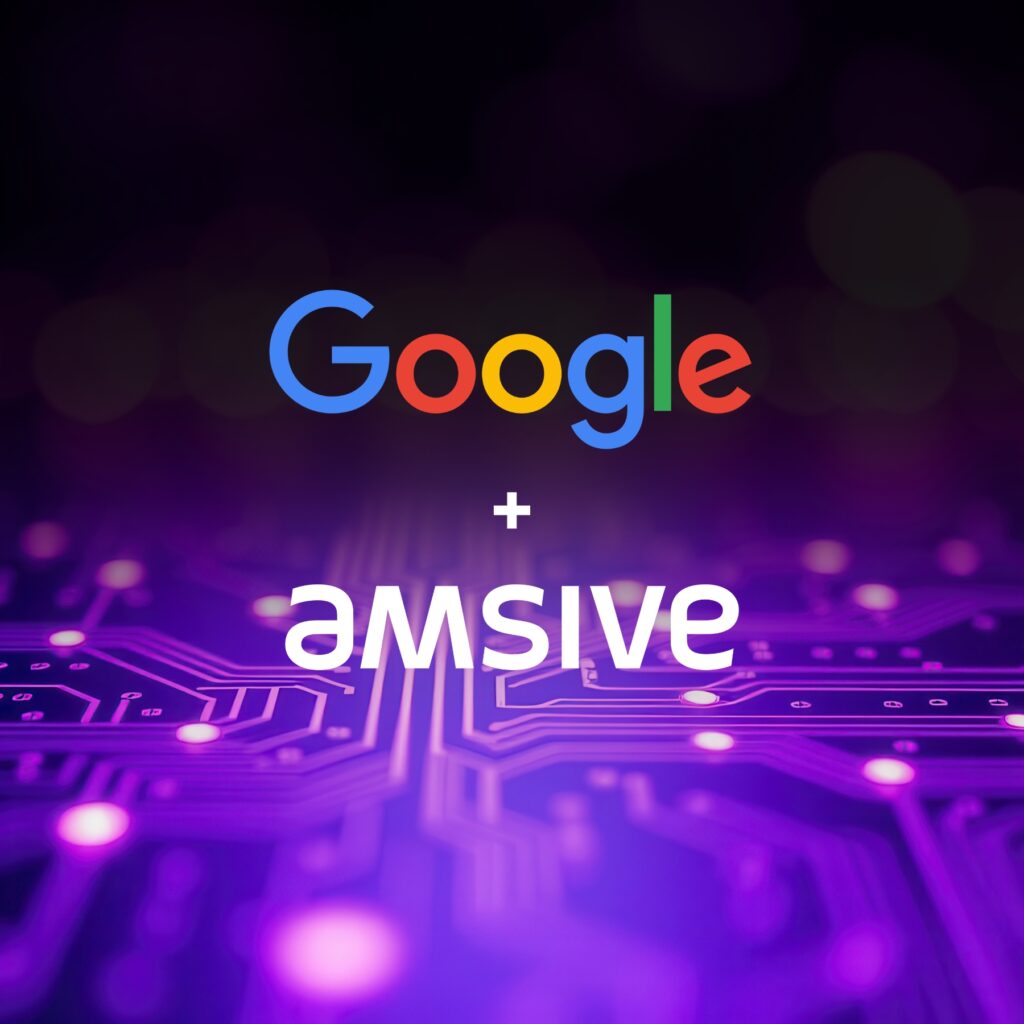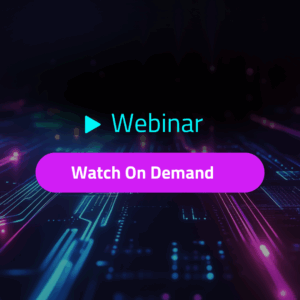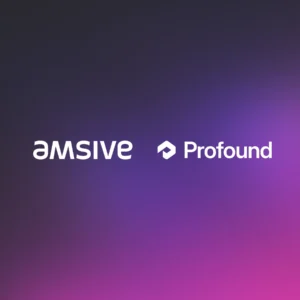Condensed from the presentation “When PPC Met SEO” from DigiMarCon Mid-South Digital Marketing Conference May 2023.
As volatility increases within the search landscape, digital media and SEO teams must collaborate more than ever before. Yet, coworkers are siloed and aren’t communicating. When informally surveyed, most marketers admit to not collaborating across teams with their SEO or digital media coworkers.
Facing similar challenges and stuck in parallel spheres, teams are missing the best opportunities within search and instead focus on individual paid and organic strategies that aren’t aligned to achieve the full force of marketing performance.
To outsmart (not outspend) your competition, your paid search and SEO teams must work together to increase efficiency, effectiveness, and the total ROI of your search efforts. Real-time communication and collaboration are required to combat the intensifying evolution of the search landscape and digital media ecosystem.
In When PPC Met SEO: A Love Story of Clicks and Keywords, learn what information is most valuable to share and how to put this knowledge into practice for your marketing strategy. Or read on for key takeaways to action with your teams!
If you’d like, you can jump to the following:
- What Paid Media Can Share with SEO
- What SEO Can Share with Paid Media
- Practical Applications
- Enhanced Audience Targeting
- VIDEO: When PPC Met SEO: A Love Story of Clicks and Keywords from DigiMarCon
What Paid Media Can Share with SEO
What information should your paid media team be sharing with their SEO counterparts? Here’s a snapshot:
- Search keywords & metrics
- Search query reports & metrics
- Top-performing paid search ad copy
- Top-performing paid social ad copy
- Top-performing audiences from social, search, display, etc.
- Promotional calendars, events, holidays, etc.
Search Keywords & Metrics
Keywords are the foundation of search engine optimization. By sharing search keywords and associated metrics, such as search volume, competition, and conversion rates, the paid media team equips the SEO team with valuable insights.
This information helps SEO professionals optimize website content, meta tags, and headings to align with popular search terms, ultimately increasing organic visibility and driving relevant traffic.
Search Query Reports & Metrics
Search query reports are critical to providing a deeper understanding of how users are searching for products or services related to the business. This information has become much more meaningful now because of the erosion of exact match keywords as Google and Bing push towards an expansion of their match types.
For instance, don’t assume that your keyword will only show up when someone searches for that exact term. Despite you bidding on a specific keyword, it can also be triggered by searches for similar or related phrases.
Analyzing the data within these reports, the SEO team can identify new keyword opportunities, long-tail search queries, and emerging search trends. Collaborating with the paid media team allows SEO professionals to refine their content strategy, target specific user intents, and enhance the overall relevance of website pages.
Top-Performing Paid Search Ad Copy
Paid search campaigns provide insights into effective ad copy that drives clicks and conversions. By sharing the top-performing ad copy, the paid media team enables the SEO team to understand the messaging and language that resonate with the target audience.
This knowledge can be applied to crafting compelling meta descriptions, title tags, and on-page content that entice users in organic search results, ultimately improving click-through rates and overall search visibility.
Top-Performing Paid Social Ad Copy
Paid social campaigns generate valuable data on what type of ad copy and messaging resonates with social media users. By sharing top-performing paid social ad copy, the paid media team empowers the SEO team to align their content strategy across different platforms.
Consistent messaging can improve brand recognition, boost user engagement, and encourage social sharing, which indirectly contributes to improved organic search performance.
Top-Performing Audiences From Social, Search, Display, Etc.
Understanding the target audience is pivotal in both SEO and paid media efforts. By sharing top-performing audience insights from various channels, such as social media, search, and display, the paid media team provides the SEO team with a better understanding of their target demographics, interests, and behaviors.
This knowledge helps refine content strategies, tailor messaging, and develop content that speaks directly to the intended audience, leading to higher engagement and improved search performance.
Promotional Calendars, Events, Holidays, Etc.
Collaboration between the paid media and SEO teams allows for effective planning and coordination of marketing efforts. By sharing promotional calendars, events, holidays, and other important dates, the paid media team ensures that the SEO team can align their content and optimization efforts accordingly.
This collaboration helps businesses capture seasonal search traffic, leverage timely promotional campaigns, and maximize the overall impact of their digital marketing activities.
Here’s a quick overview of what your paid media team should share with your SEO team.
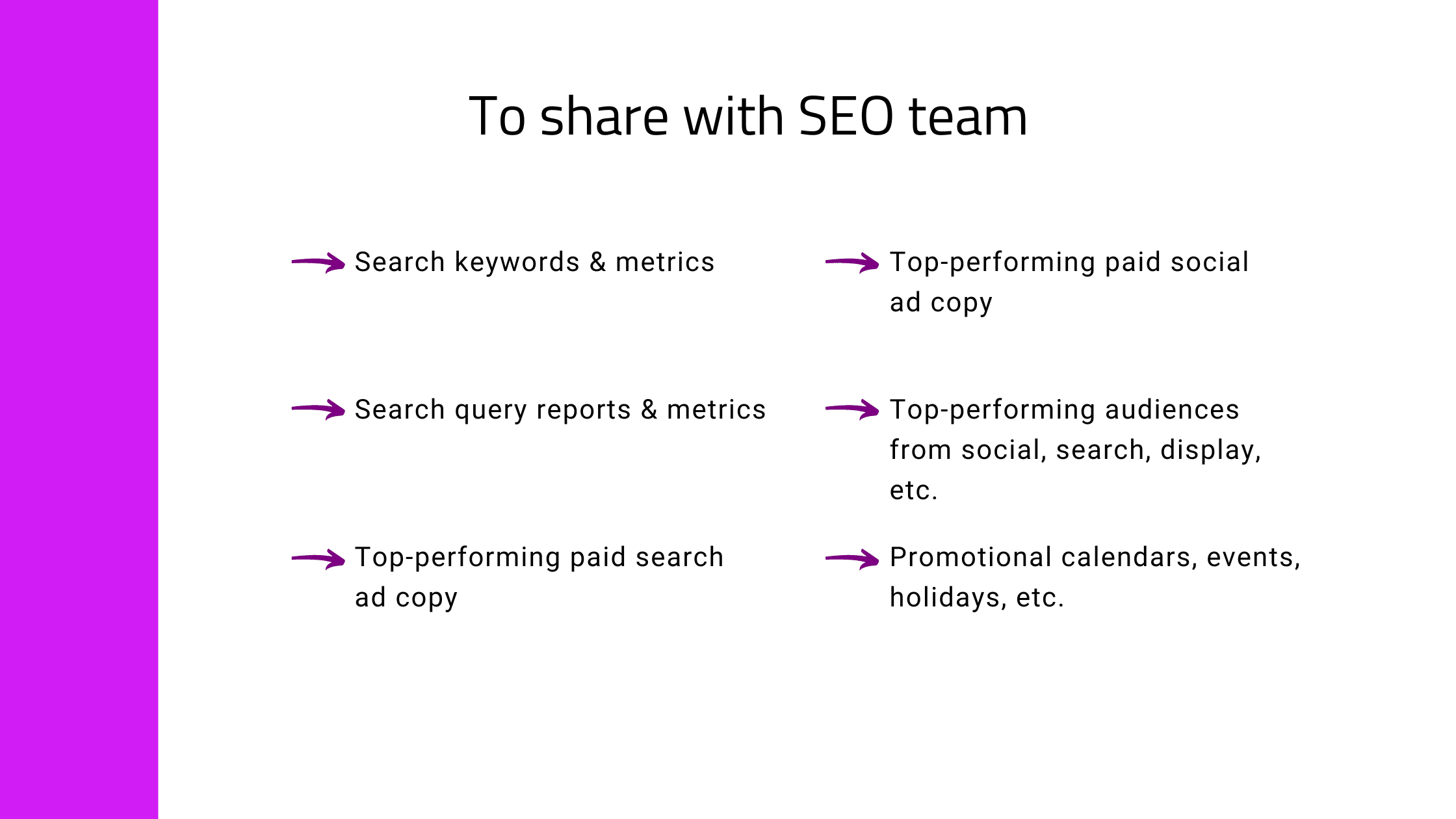
What SEO Team Can Share with Paid Media
What information should your SEO team be sharing with paid search colleagues? Here’s where to start:
- Page 1 ranked & striking distance keywords & performance
- Meta titles & meta descriptions
- Top content & organic landing pages
- Google Search Console (GSC) keyword data
- Google Business Profile (GBP) optimizations
- Organic search trends & performance
- Technical SEO recommendations & mobile page speed optimizations
Page 1 Ranked & Striking Distance Keywords & Performance
Page 1 ranked keywords are those that have already achieved a top ranking on search engine result pages (SERPs). Information can be easily pulled through GSC and other SEO and analytics tools. Sharing this information with the paid team enables them to align their paid search campaigns with high-performing organic keywords, optimizing ad relevancy and potentially lowering cost-per-click (CPC).
Additionally, striking distance keywords, which are on Page 2 or lower, provide an opportunity for the paid team to invest in targeted advertising to boost organic visibility and expedite organic growth. SEO teams have an opportunity to hit Page 1 with additional content strategy to help keywords rank higher.
Meta Titles & Meta Descriptions
Meta titles and meta descriptions play a crucial role in attracting users’ attention and influencing click-through rates (CTRs) in search results. By sharing meta titles and descriptions that have been tested and proven effective, the SEO team provides the paid team with valuable insights into messaging and language that resonates with users.
This knowledge can be utilized to optimize paid search ad copy, ensuring consistency between organic and paid listings, enhancing user experience, and driving higher CTRs.
Top Content & Organic Landing Pages
Sharing information about top-performing content and organic landing pages is invaluable for the paid team. This data helps them understand which pages are driving organic traffic, engaging users, and generating conversions.
By aligning their paid search campaigns with these high-performing pages, the paid team can create tailored ad copy and landing page experiences, amplifying the chances of conversions and ultimately maximizing ROI.
Google Search Console (GSC) Keyword Data
Google Search Console provides comprehensive keyword data, including impressions, clicks, and average position, giving the SEO team valuable insights into the performance of their organic keywords. Sharing this information with the paid team enables them to identify high-potential keywords for targeted paid search campaigns.
Moreover, the collaboration facilitates a cohesive keyword strategy that combines organic and paid efforts, reinforcing brand presence and driving more qualified traffic.
Google Business Profile (GBP) Optimizations
Optimizing their Google Business Profile is crucial for local businesses to enhance their visibility in local search results. By sharing GBP optimizations with the paid team, the SEO team ensures consistency between organic and paid local search efforts.
This collaboration helps create a cohesive brand presence, boosts local ad relevance, and increases the likelihood of local conversions.
Organic Search Trends & Performance
Staying updated with organic search trends and performance is fundamental for SEO and paid search success. The SEO team’s insights into emerging search trends and shifting user behavior can guide the paid team in targeting new market segments, adjusting ad messaging, and optimizing bidding strategies.
By sharing this information, the SEO team empowers the paid team to leverage the latest trends, stay ahead of the competition, and enhance overall search performance.
Technical SEO Recommendations & Mobile Page Speed Optimizations
Technical SEO plays a pivotal role in search performance. By sharing technical SEO recommendations and mobile page speed optimizations, the SEO team equips the paid team with valuable insights into website performance, user experience, and mobile optimization.
Collaboration in this area allows the paid team to align their landing page experiences with SEO best practices, improving quality scores, user satisfaction, and ad performance.
Here’s a snapshot of what your SEO team should share with your paid team.
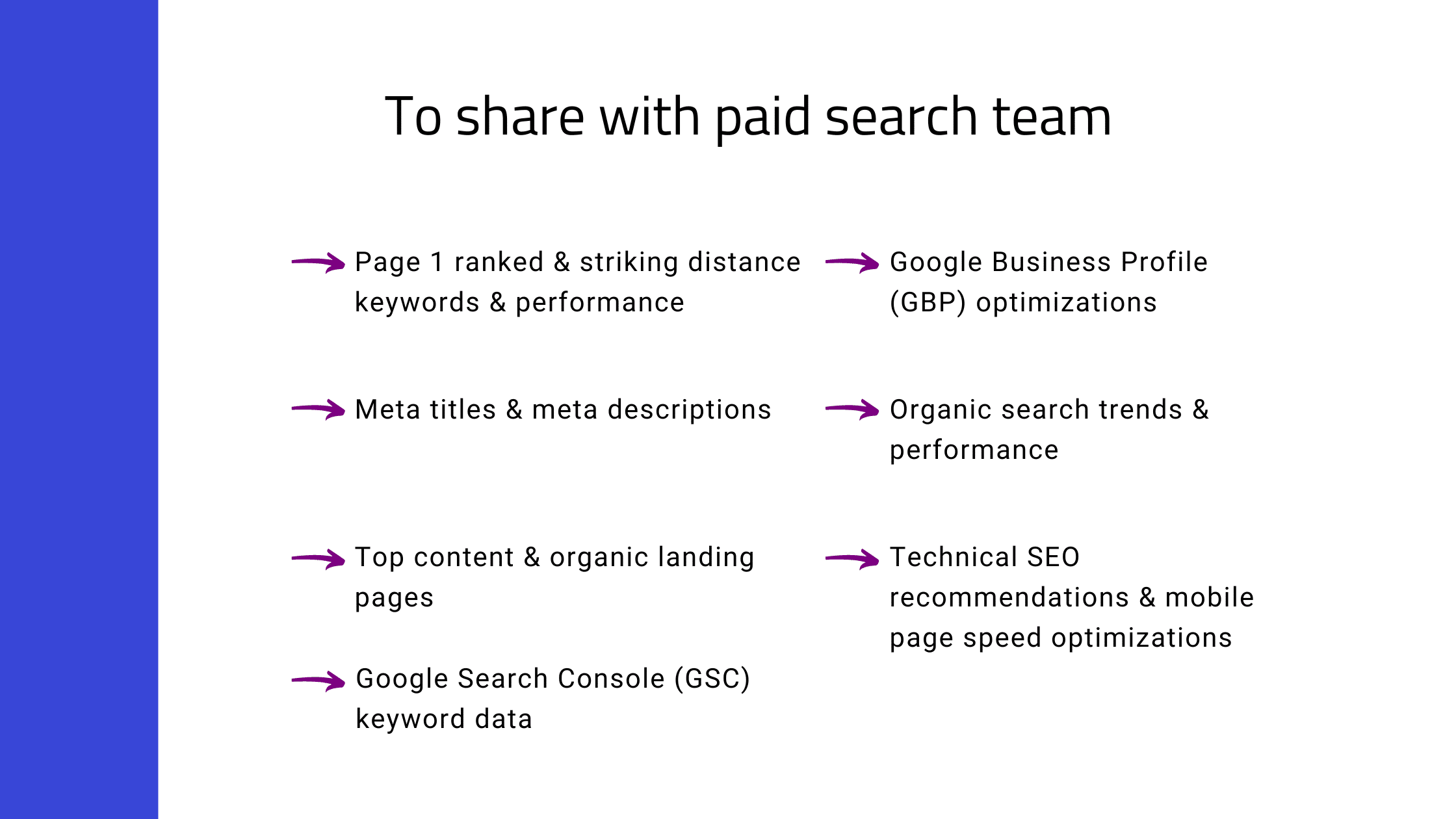
Practical Applications of PPC and SEO Information
Here’s how you can bring together PPC and SEO insights to improve your marketing performance.
You’ll need to collect the following:
- PPC: Search keywords + metrics
- PPC: Search query reports + metrics
- SEO: Page 1 ranked + striking distance keywords + performance
- SEO: Google Search Console data
This shared information can be applied to determine the profitability of SEO keywords, multi-language and regional keyword expansion, identify and prioritize keywords too expensive for paid search but rankable for organic, and be used for paid search queries to build site content, FAQs, and site links.
Sharing search query reports, Page 1-ranked and striking distance keywords, Google Search Console data, top-performing landing pages, and meta titles and descriptions enhances collaboration between the SEO and paid teams.
These insights enable the teams to optimize their strategies, align their messaging, improve user experience, and drive better search performance.
Enhanced Audience Targeting
In the context of collaboration between the paid and SEO teams, it’s important to consider the scope of audience targeting. The paid media team focuses on the audiences they are targeting within specific platforms like Facebook.
This includes using features such as look-alike audiences or built-in audience targets provided by the platform. They also consider demographics, age groups, genders, locations, and other relevant criteria when defining their target audience.
On the other hand, the SEO team should share audience data from Google Analytics (GA). This goes beyond just paid sources and encompasses a broader view of the website’s audience. GA provides insights into the various audiences visiting the site and how they are categorized within the analytics platform.
This data helps identify which audiences are converting most effectively and provides valuable information for optimizing SEO strategies.
In summary, the paid media team shares information about their targeted audiences within specific platforms, while the SEO team shares GA audience data, including insights on overall website visitors and audience categorization.
By exchanging this information, both teams gain a comprehensive understanding of audience behavior and can make informed decisions to improve their targeting and optimization efforts.
In audience targeting, it’s important to approach it in two phases: audience discovery and audience optimization. During the audience discovery phase, we use data-driven analysis to identify and define the audiences or segments that align with our client’s business goals. This involves understanding who our target audience is across various platforms.
However, within these defined audiences, there may be multiple segments that require ongoing measurement and analysis. This leads us to the audience optimization phase, where we continuously evaluate and optimize the performance of these audience segments.
It’s crucial to regularly assess how these audiences are performing and make necessary adjustments to ensure optimal results.
By adopting this approach, we can effectively discover and define our target audiences while continuously refining our strategies to improve audience performance. This iterative process ensures we stay proactive and adaptable rather than simply setting and forgetting our audience targeting efforts.
Communication Between Teams & Tools
In the process of sharing information between paid and SEO teams, there are several key elements to consider. One important aspect is the ability to measure and communicate the value of SEO efforts to stakeholders. This can be achieved by identifying high-performing organic keywords, particularly those that rank on page one of search results.
By analyzing the traffic and performance metrics associated with these keywords, such as click-through rates and conversions, it becomes possible to quantify the revenue generated from SEO.
Furthermore, it is essential to gather paid search metrics that align with the organic keywords of interest. This involves identifying keywords that overlap with the Page 1 ranking and striking distance keywords.
By comparing the performance metrics of paid and organic keywords, such as click-through rates, conversion rates, cost per click, and return on ad spend, it becomes possible to gauge the impact and profitability of both channels.
Another valuable source of insight is Google Analytics, which provides a wealth of audience data. By sharing this information between paid and SEO teams, it becomes easier to align targeting strategies and creative decisions based on audience characteristics and behavior.
Additionally, monitoring organic search trends and performance is crucial. By comparing the trends in organic and paid search traffic, one can gain insights into the overall marketplace demand and identify any discrepancies that may indicate issues with paid media or tracking.
By implementing effective information-sharing practices between paid and SEO teams, organizations can optimize their strategies, measure the impact of their efforts, and ensure alignment in achieving business goals.
The Benefits of Collaboration
In short, there are many. Coordinating efforts between the paid and SEO teams is invaluable to your marketing performance.
First, it allows for better targeting of different stages of the customer journey, resulting in more effective campaigns. By sharing insights and data, the teams can optimize budget allocation, reduce duplication of efforts, and achieve cost optimization and efficiency.
Furthermore, the collaboration enables data-driven optimization, as the teams can identify common trends or isolate specific insights that lead to continuous campaign improvements. They can explore messaging options, create more relevant content, and optimize conversions across channels, resulting in a stronger brand presence and consistent brand messaging.
Maximizing visibility is another advantage of aligning paid and SEO efforts. When a brand ranks on page one organically and also has a paid ad appearing at the top of the search engine results page, it occupies more space and reduces the opportunity for competitors to gain visibility.
Overall, the combined efforts and comprehensive keyword strategy can lead to greater visibility and exposure for the brand, resulting in improved performance and market presence.
Dive further into this topic and see real-life examples in the following video from DigiMarCon 2023.
VIDEO: When PPC Met SEO: A Love Story of Clicks and Keywords from DigiMarCon 2023
Take the Next Step Towards Collaboration
In conclusion, the rapidly changing search landscape and increasing volatility in digital media necessitates a strong collaboration between paid search (PPC) and SEO teams. By breaking down the silos and encouraging open communication, marketers can harness the full potential of their search efforts and achieve better results.
The union of these two distinct yet complementary disciplines can lead to increased efficiency, effectiveness, and a higher ROI on your search marketing efforts, especially when reaching the right audience.
To truly outsmart your competition and not just outspend them, ensure that your paid search and SEO teams are working in harmony. Embrace the power of collaboration and foster a culture that supports real-time communication and the exchange of ideas.
By doing so, you’ll create a dynamic and adaptable search marketing strategy that thrives in the face of change and drives long-lasting success. Remember, when PPC and SEO join forces, the result is a love story that brings the best of both worlds together, unlocking new opportunities and propelling your brand to new heights.
Better paid media and SEO collaboration is just one piece that’s needed to succeed in today’s landscape. Learn more about how AI is impacting paid and organic search, or let’s talk about how to achieve more for your marketing — and your business.
